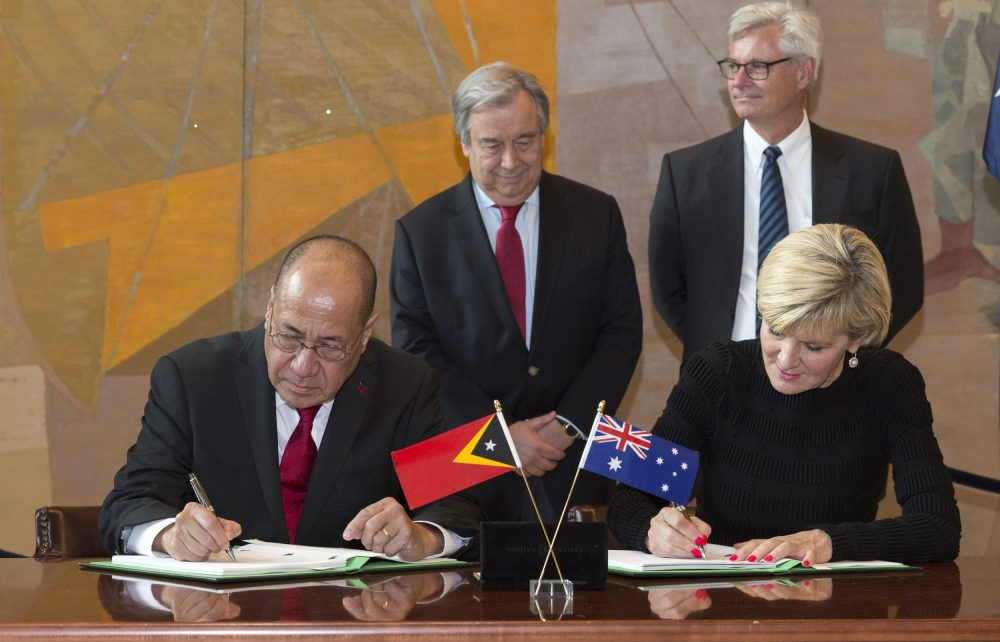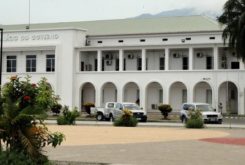After more than a decade of dispute, on 6 March the governments of Timor-Leste and Australia finally put pen to paper on an agreement to delimit their common maritime boundary. The deal should allow the development of the Greater Sunrise oil and gas project. Yet it is important to point out that this is a political settlement rather than a commercial one. The two governments still need to reach agreement with the development consortium on where the gas should be processed and this is far from a foregone conclusion.
The political dispute centred on disagreement over how to delimit the maritime boundary in the Timor Sea. Dili based its sovereignty claim on the principle of equidistance, which requires boundaries to be drawn exactly half way between the coastlines of the two countries. By contrast, Australia wanted to use the midpoint of the two continental shelves, under the principle of ‘natural prolongation’. Both methods are recognised, although Australia’s approach is far less common.
The original boundary delimitation agreement was drawn up between Australia and Indonesia in 1972 but was never ratified. It was understandably favourable to Australia and the Timorese to refuse to abide by it even before the country became independent. In doing so, Dili rejected the principle of uti possidetis iuris, which lays down that newly independent states should accept international agreements signed by their former colonial power or the state from which they have seceded.
Former Spanish and Portuguese colonies in South America started the trend of using uti possidetis iuris when they gained independence, in order to avoid a territorial free-for-all. It was also followed by the entire African continent in the 1960s, but there is nothing binding in international law that required Timor-Leste to follow suit. Canberra appeared to recognise the weakness of the 1972 deal by withdrawing from the compulsory jurisdiction of the International Court of Justice in the run up to independence.
A Joint Petroleum Development Area (JPDA) was created after independence to enable the development of a separate offshore field, Bayu Undan, on which Timor-Leste takes 90% of all revenue and which has been developed by a ConocoPhillips-led consortium. About 80% of the Greater Sunrise reserves lie outside the JPDA and so it could not be developed without either greatly expanding the zone or boundary delimitation.
Bullying claims
Canberra has been accused of bullying because of Dili’s economic frailty and the gross imbalance in political and economic power between the two countries. Australia has enjoyed one of the fastest growing economies among industrialised nations over the past decade, in part fuelled by its own massive gas boom that should see the country overtake Qatar as the world’s biggest liquefied natural gas (LNG) exporter by the end of next year.
The spokesperson for the Timor Sea Justice Campaign, Tom Clarke, said: “There really isn’t much that the Australian government can be proud of. It lied and cheated to short-change East Timor at every opportunity.” It certainly appears to have used its position as Timor-Leste’s biggest foreign donor to exert some leverage in negotiations, although Dili has not been slow to incorporate this impression in its own PR strategy.
The pressure on Dili has ratcheted up over the past couple of years. Oil production stood at 37,000 b/d at the end of last year but production on existing fields will be exhausted within five years. The country has made some economic progress since gaining independence in 2002, although the level of that progress is the subject of intense debate.
Hydrocarbons, mainly from Bayu Undan, have accounted for up to 90% of government revenues and the prospect of this income disappearing with no obvious replacement cast a big shadow over government policy. The dispute’s importance was such that Dili created a new ministry, for boundary delimitation, to handle the negotiations.
The deal reached in March, under the United Nations Compulsory Conciliation process, largely accepted Timor-Leste’s demands and is a huge improvement on the previous proposals. When Dili managed to include a 50:50 split of revenues in a preliminary deal in 2005, this was widely trumpeted as a success, including by Timorese ministers. The timing of the settlement may also be designed to bolster the government’s reputation in the run-up to this May’s election.
Greater Sunrise
The Greater Sunrise project relates to the development of two gas and condensate fields: Sunrise and Troubadour, which were both discovered in 1974. They contain estimated gas reserves of 5.13 trillion cu ft and 225.9 million barrels of condensate, although there could be substantially more.
The fields lie in water depths of between 100m and 600m, 150km southeast of Timor-Leste and 450km northwest of Darwin in Australia. The long running dispute between the two countries has discouraged further exploration work in the area but this could be stepped up once the final investment decision is taken on developing the project.
Given the lack of gas demand in Timor and northern Australia, the obvious way to commercialise the gas reserves is through the production and export of LNG. The Greater Sunrise consortium is operated by Australian firm Woodside with 33.44% equity, alongside partners ConocoPhillips (30%), Shell (26.56%) and Osaka Gas (10%). The Japanese company’s inclusion is indicative of the fact that a lot of the gas produced on Greater Sunrise will be shipped to Japan, which is still the world’s biggest LNG market.
LNG production
The agreement does not mark the end of negotiations, as the location of the LNG plant still has to be decided. The gas could either be piped north to Timor, perhaps at Beco, or south to Darwin in Australia. Each government wants it piped to their territory. Australia has great experience in developing such projects but the economic benefits to Timor-Leste could be huge.
Former prime minister and chief negotiator Xanana Gusmao says that piping the gas to Timor-Leste is “non-negotiable”. The minister for boundary delimitation, Hermenegildo Augusto Cabral Pereira, said: “We believe seriously that a successful pipeline to the south coast of Timor would be a game changer and have a transformational impact on the socio-economic status of the country.”
Most media reports have suggested that revenues will be divided 70:30 in favour of Timor-Leste. This will only be the case if the gas is piped onshore Timor-Leste for processing. If it goes to Australia, Timor-Leste’s share will go up to 80% to compensate for the lack of industrial development and employment. The government needs to think hard about which of these two options to back, as it may be overestimating the benefits of onshore processing.
The required engineering, management, construction and IT services are all highly specialised and few Timorese companies will be in a position to provide them. Similarly, few Timorese are likely to have the qualifications and experience in the oil and gas industry to take up employment immediately. In other countries where oil and gas activity expands rapidly, local people most readily find jobs is in security, catering and similar occupations.
No matter where the gas is processed, the ability of the country to extract as much benefit out of the industry as possible will depend on how effective it is in ensuring that foreign contractors work with local partners on skills and capacity transfer; and on demanding that foreign companies help to train local people for more skilled positions.
The development consortium certainly favours the Australian option. Gusmao has accused Canberra of colluding with it to ensure that the pipeline is built to Australia. There are certainly advantages to this. Although the gas lies closer to Timor than Australia, any pipeline to Timor-Leste would pose genuine engineering challenges as it would have to traverse the Timor Trough, which is 3,500m deep.
In addition, Greater Sunrise gas could be piped to the existing Darwin LNG project, which is currently supplied by Bayu Undan. Reserves on that field are already being depleted and so a new source of supply will, in any case, have to be identified. In addition, the existing Bayu Undan pipeline could be utilised. However, this option may disappear if no settlement is reached and ConocoPhillips has to source gas from another field to supply Darwin LNG. Infrastructural costs for the entire project are estimated at $15.6 billion for the Timorese option, several billion dollars more than for the Darwin alternative.
Global LNG trends
The consortium’s determination to develop the project has probably been weakened over the past few years because of the sheer number of LNG schemes under development elsewhere in the world, particularly in Australia and the United States. Australia is expected secure production capacity of 86.6 million metric tonnes (mt)/year by the second half of next year, up from 44.9 million mt in 2016. In addition, five US projects with combined production capacity of 64 mt/year will come on stream by 2025.
Other projects have been delayed by the wave of new capacity, including in emerging producers, such as Mozambique and Tanzania. However, prices have not been depressed by the new schemes as much as expected and there is growing appetite in the industry to begin developing additional capacity after 2022. In April, Australia’s Department of Industry, Innovation and Science was forced to recalculate its price forecasts. It now predicts an average price of $8.20/million Btu for 2018-19, a full dollar higher than it predicted in January.
The Timor-Leste-Australia boundary agreement may have come at just the right time to enable development of Greater Sunrise. The project will be ideally placed to supply the world’s biggest LNG markets: Japan; China, which has just overtaken South Korea; and Taiwan. It usually takes about five years to develop LNG projects.
However, Greater Sunrise would make the Timorese economy even more dependent on oil and gas revenue, so it is imperative that the government works hard to diversify the country’s economic base. It has already set up a sovereign wealth fund and this can be greatly expanded with income from the new project. At the same time, it needs to invest in infrastructure, education and other sectors that can deliver more jobs. Opting for the 10% extra revenue from liquefaction taking place in Australia would give it more money to finance such projects.



